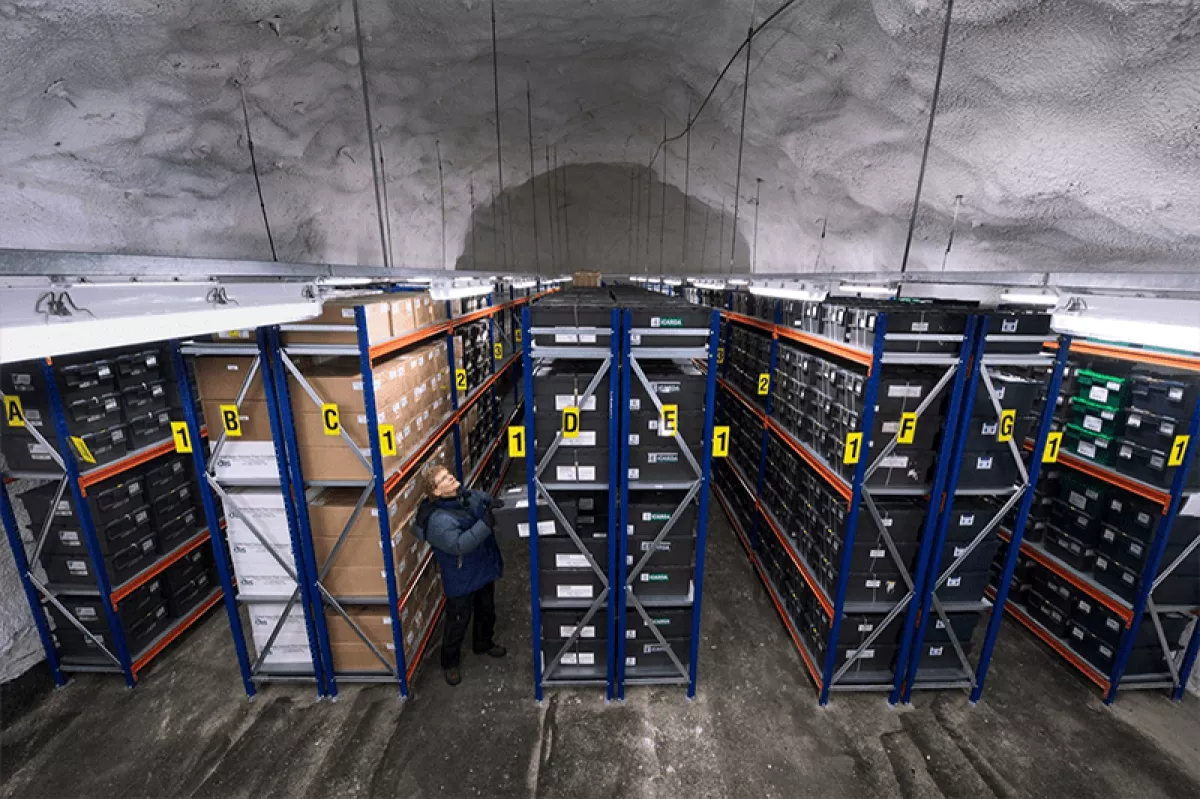Arctic “doomsday vault” where world’s precious agricultural seeds are stored Photo
The wave of wars erupting around the world in 2025 is claiming some unexpected victims. In conflict zones stretching from Ukraine to Palestine, critical seed storage sites that safeguard future crop diversity are being destroyed. Scientists are now racing to rescue and relocate remaining collections to a remote Arctic facility known as the “doomsday vault” in Norway, where they can be preserved for future food security in an increasingly unstable climate.
This facility, the Svalbard Global Seed Vault, sits on the island of Spitzbergen in Norway’s Svalbard archipelago, far inside the Arctic Circle. According to an article published by Yale University, it is considered the world’s ultimate backup, a frozen reserve designed to protect crop biodiversity for generations to come.
“As the world grows more unstable, the risks to our priceless seed collections are increasing,” says Geoffrey Hawtin, a leading agricultural researcher who helped establish both the Svalbard vault and a global treaty on seed sharing.
The situation is most dire in Sudan. For four decades, the country’s national seed bank in Wad Medani, located along the Blue Nile, preserved thousands of traditional varieties of sorghum, millet, and other indigenous crops.
These heirloom varieties, while no longer widely cultivated, are seen as vital for their ability to survive extreme drought and rising heat.
But in December 2023, shortly after civil war erupted in Sudan, fighters from the RSF group stormed the facility and drove out its staff. More than a year later, when researchers returned, they found the vault emptied and its seeds strewn and degraded.
Ali Babiker, director of Sudan’s plant genetic resources, salvaged what he could from a secondary research center in Elobeid, a city that had also been besieged. In February, he shipped those remaining samples to Svalbard for safekeeping. Still, only about 25% of Sudan’s irreplaceable collection has so far been recovered, processed, and sent to Norway’s icy sanctuary.
Ukraine faces a parallel crisis. Once known as one of the world’s top grain producers, Ukraine’s agricultural productivity has long depended on plant varieties stored at its national seed bank in Kharkiv. Ranked among the world’s 10 largest gene banks, the Kharkiv facility held thousands of unique lines of wheat, barley, and rapeseed.
In May 2022, Kharkiv—then a frontline city—was shelled by Russian forces. The seed bank’s buildings and surrounding research fields took damage. Fortunately, much of the collection survived, and staff later moved it to a hidden location in western Ukraine. But some of their experimental fields and seed stock remain in Russian-controlled areas.
“We’re working to duplicate the gene pool,” says Viktor Ryabchun, director of Ukraine’s National Center of Plant Genetic Resources. Ukraine has agreed in principle to join the 2001 international seed-sharing treaty and transfer seeds to Svalbard, but progress has stalled. Of Ukraine’s 154,000 seed samples—roughly a quarter of which exist nowhere else—fewer than 2,800 have so far been backed up in the Arctic vault.
Palestinian seed collections have fared somewhat better. Since 2003, the Union of Agricultural Work Committees (UAWC), a nonprofit research group, has managed a seed bank in Hebron that houses West Bank and Gaza varieties of vegetables like tomatoes, eggplants, zucchini, and cucumbers. Its goal is to protect local crops from extinction amid increasing Israeli encroachments.
In 2021, Israel accused UAWC of ties to the Popular Front for the Liberation of Palestine and labeled it a terrorist group, closing its Ramallah offices. However, the UN and European Union have not endorsed the accusation and continue cooperating with the group.
Despite the political turmoil, the Hebron seed bank remains operational. “It’s a unique collection from one of the oldest centers of crop domestication,” says Hawtin. “It holds material with potential global value.” In October, the seed bank sent its first samples to Svalbard.
Origins of seed banking
Modern seed conservation began in Russia, where pioneering agronomist Nikolai Vavilov established the first formal seed bank in 1921. Today, most countries operate national seed banks, supported by a global network of 11 international facilities run under the CGIAR partnership, largely funded by governments.

Worries over the long-term security of these repositories led Hawtin and colleagues to push for a secure global backup. That vision became reality in 2008, when the Svalbard Global Seed Vault opened near the town of Longyearbyen. Dug deep into permafrost and protected by thick rock, it now holds hundreds of millions of seeds—over 1.3 million varieties from more than 6,000 species—contributed by 87 countries.
Last year, Svalbard accepted duplicates from the Philippines’ national seed bank in Los Banos. That facility has twice suffered devastating losses: first from a typhoon in 2006, and then from a fire in 2012.
Chad also made its first deposit, sending over a thousand seed samples of sesame, maize, rice, and sorghum. These crops, bred for the country’s tough desert conditions, may become essential as climate extremes worsen.
Scientists hope that alongside drought resistance, the Svalbard vault can preserve genes for other crucial traits like pest and disease resistance, or tolerance to novel climate stressors. As a true “doomsday vault,” it is intended as a final fallback—capable of helping humanity recover in the aftermath of cataclysmic events like asteroid strikes, volcanic super-eruptions, or nuclear war.
By Nazrin Sadigova








